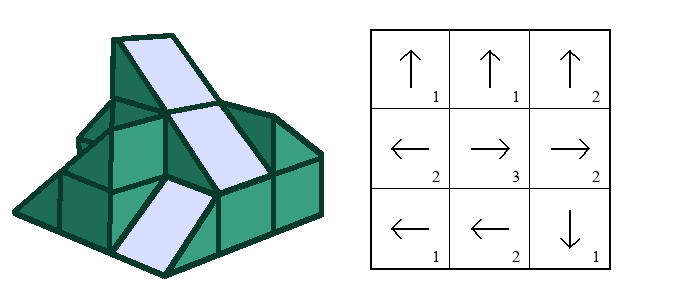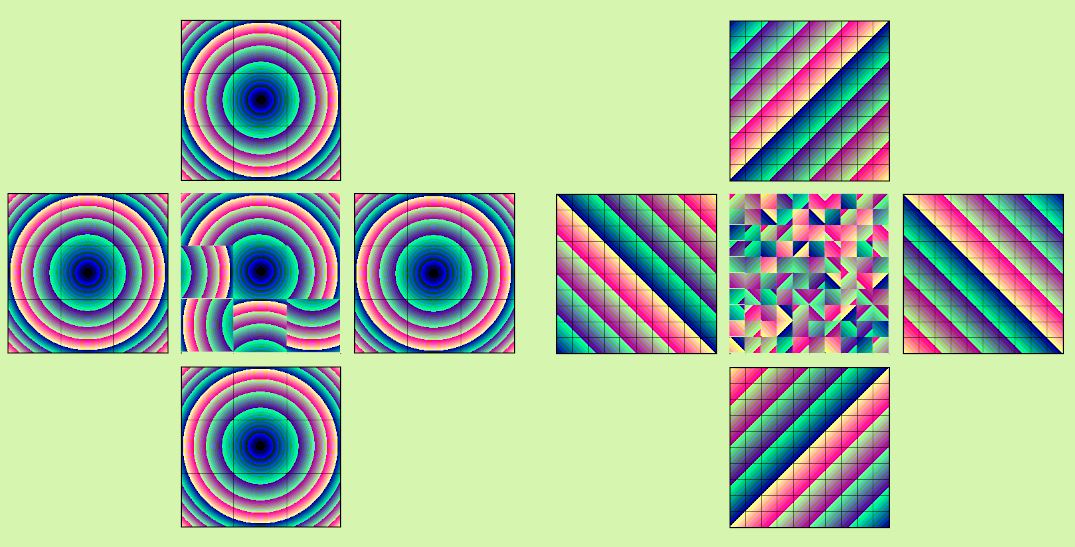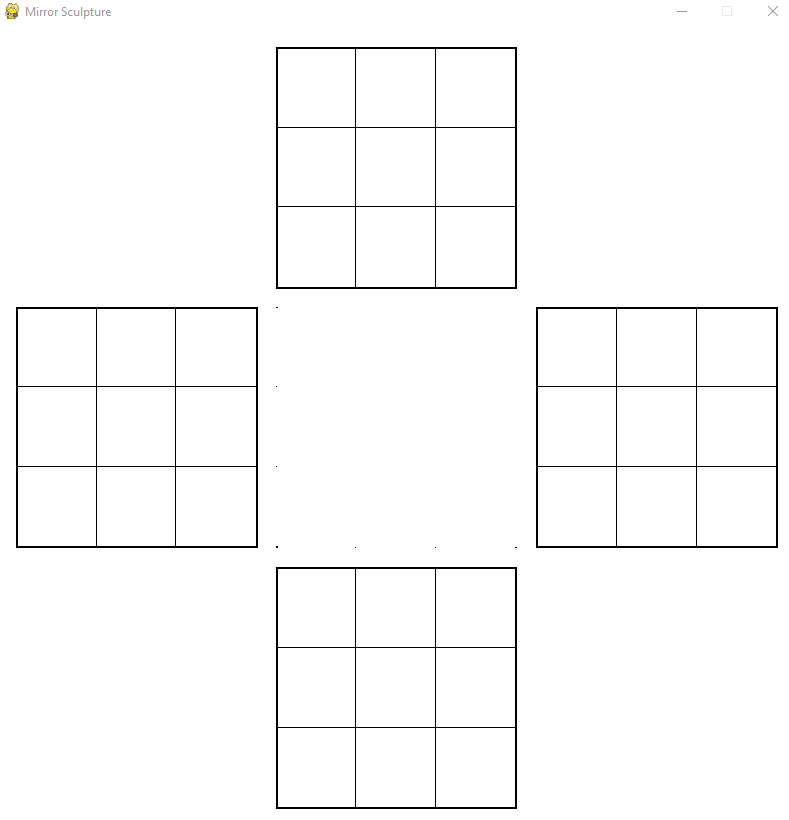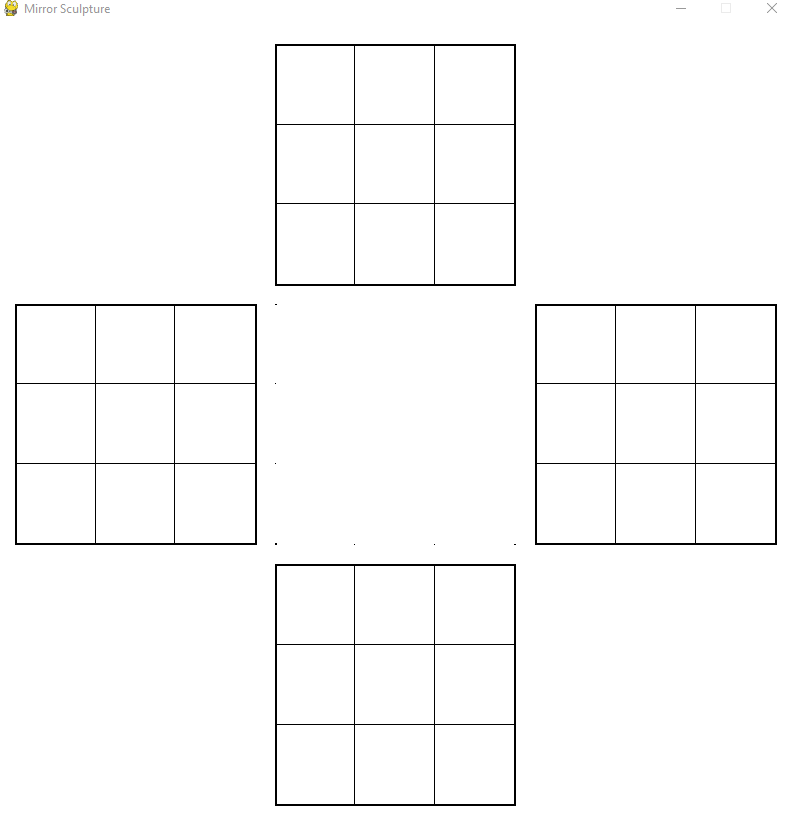Mirror Sculptures
4 min read
TLDR
(click to show/hide)
I made an art project using some combinatorial arrangement of mirrors that will encode / decode sets of images.
I first made a software tool to help visualize different arrangements and then build a physical model as a proof of concept.
There are some combinatorial questions about the nubmer of such arrangments that exist that I was interested in, but are left
open ended at the bottom of the article.
In high school, I spent a lot of time working on art and always liked to add mathy twists to my projects. Usually this was in the form of puzzles, codes, and references to
other fields liked linguistics and computer science, but sometimes I would have an idea which would require some calculations to even get started on. One project I never got around to was my idea for 'mirror
sculptures.' This was in part because I didn't have the tools necessary to build the sculpture but also because it was hard for me to plan out (most of my planning was done
with pencil and paper which seemed like it would be hard to do with this project).
These would be similar to cylindrical mirror art but would be gridded and have many more variations. Each sculpture would consist of wooden cubes stacked at various heights
with a 45-degree mirror attached to the top facing in one of the four possible directions. Mirrors would reflect drawings on the sides of the sculpture upward to reveal the hidden
image. This idea especially interested me since the number of unique sculptures to make was enormous as the size of the grid grew and, if planned correctly, I could hide multiple
images that only the corresponding sculpture would reveal.

An example of a valid but non-perfect sculpture with its top-down visualization
Recently, I've created a tool to help generate and visualize sculptures before trying to build one. The code has three modes, Premade Image Viewing, Image Drawing, and Reflection Drawing. Before going into these, I will explain some terminology
I've been using. Sculptures are N x N grids of blocks each having a direction and a height. Directions are values 1 to 4 which start at the top and go clockwise and heights are values 1 to N. The line of sight
of a block is the set of blocks in the direction the block is pointing. A valid sculpture is a sculpture for which all blocks have a height strictly greater than the blocks in their line of sight (ie. none are blocked by another).
A perfect sculpture is a valid sculpture whose blocks reflect exactly all N x N possible grid cells on an image. That is, if we write the digits 1 through N^2 in the cells of an image, each number would appear in the reflection exactly
once when we move the image to each of the four possible locations.
Now we can take a look at some of the features of the tool:
Premade Image Viewing
We can place premade images along either premade or random sculptures to see what the reflection will look like. Randomized sculptures are not guaranteed to be either valid or perfect but can be any size.

Premade images on random sculptures of sizes 3 and 10
Image Drawing
In this mode, the user is able to draw each of the four images surrounding the sculpture separately and view what the corresponding reflection would be at the top. Here, you can see a user drawing each of the images with the mouse, press space to view
the top-down sculpture visualization, and then hovering over the sculpture to see which image piece corresponds to which part of the reflection.
Image drawing tool on the example sculpture above
Reflection Drawing
Reflection drawing is the most useful of all 3 tools. It enables us to draw what we would want to see reflected in the sculpture and then creates the images needed to produce such a reflection.
Reflection drawing tool on the example sculpture above
I was able to create a real-world version of a perfect sculpture with a number of cool images which can be reflected. For the blocks, I cut 1.75in square dowels into cubes and
and then cut nine of these down the diagonal to create my ramps. Using glass cutter, I cut my mirror into 1.75 x 2.47in rectangles and glued these onto the ramps. I designed a perfect 3x3 sculpture manually in
the tool and then used the reflection drawing mode to figure out what images I would need to display 4 different impossible shapes in the reflection.
Set of images designed with the reflection tool and drawn with sharpie
The four reflections seen when rotating the images through their possible configurations
This was a fun project to work on this summer since I haven't made a lot of art recently. There are still some combinatorics related questions I have about the sculptures, namely,
how many valid sculptures are there for size N up to rotation and how many perfect sculptures are there for size N up to rotation? I'll leave those for another article though!





